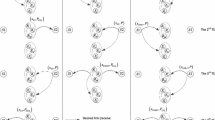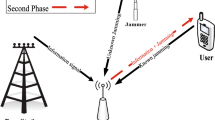Abstract
Physical layer security is an emerging security paradigm that can achieve secure information transmission from the source to the intended destination with the existence of malicious eavesdroppers. In this paper, joint relay/jammer selection and power control with friendly jammers for physical layer security in two-way relay networks are studied. First, several relay/jammer selection schemes are proposed to increase the secrecy capacity for source nodes and degrade the eavesdropper links simultaneously. The presented schemes select one conventional relay node and at most two friendly jammers among a number of intermediate nodes. The impact of channel estimation error on the wiretap channel is also considered. After the selection of optimal relay node and friendly jammers, a game-theoretic power control approach is introduced to deal with the interaction between the source nodes and the friendly jammers. The proposed power control approach is proven to be able to converge to the Stackelberg equilibrium, and both source nodes and friendly jammers can obtain their optimal benefits. The simulation results demonstrate the effectiveness of the relay/jammer selection schemes to enhance the secrecy capacity of the system, and validate the properties of optimization and convergence for the game-theoretic power control approach.







Similar content being viewed by others
References
Wyner, A. D. (1975). The wire-tap channel. Bell System Technical Journal, 54(8), 1355–1387.
Tang, X. J., Liu, R. H., Spasojevic, P., & Poor, H. V.: The Gaussian wiretap channel with a helping interferer. In Proceeding IEEE International Symposium Information Theory (ISIT 2008), Toronto, Canada (pp. 389–393).
Bloch, M., Barros, J., Rodrigues, M. R. D., & McLaughlin, S. W. (2008). Wireless information-theoretic security. IEEE Transactions on Information Theory, 54, 2515–2534.
Dong, L., Han, Z., Petropulu, A. P., & Poor, H. V. (2010). Improving wireless physical layer security via cooperating relays. IEEE Transactions on Signal Processing, 58(3), 1875–1888.
Zheng, G., Choo, L. C., & Wong, K. K. (2011). Optimal cooperative jamming to enhance physical layer security using relays, signal processing. IEEE Transactions on 59(3), 1317–1322.
Li, J., Petropulu, A. P., & Weber, S. (2011). On cooperative relaying schemes for wireless physical layer security. Signal Processing, IEEE Transactions on 59(10), 4985–4997.
Lai, L. F., & Gamal, H. E. (2008). The relay-eavesdropper channel: Cooperation for secrecy. IEEE Transactions on Information Theory, 54(9), 4005–4019.
Ding, Z. G., Leung, K. K., Goeckel, D. L., & Towsley, D. (2011). Opportunistic relaying for secrecy communications: Cooperative jamming vs. relay chatting. IEEE Transactions on Wireless Communications, 10(6), 1725–1729.
Huang, J., & Swindlehurst, A. L. (2011). Cooperative jamming for secure communications in MIMO relay networks. IEEE Transactions on Signal Processing, 59(10), 4871–4884.
Nam, W., Chung, S. Y., & Lee, Y. H. (2010). Capacity of the Gaussian two-way relay channel to within 1/2 bit. Information Theory, IEEE Transactions on 56(11), 5488–5494.
Zhang, R.Q., Song, L.Y., Han, Z., Jiao, B.L., & Debbah, M. (2010). Physical layer security for two way relay communications with friendly jammers. 2010 IEEE Global Communications Conference (GLOBECOM 2010), Miami, Florida (pp. 1–6).
Zhang, R. Q., Song, L. Y., Han, Z., & Jiao, B. L. (2012). Physical layer security for two-way untrusted relaying with friendly jammers. IEEE Transactions on Vehicular Technology, 61(8), 3693–3704.
Wang, H. M., Yin, Q. Y., & Xia, X. G. (2012). Distributed beamforming for physical-layer security of two-way relay networks. IEEE Transactions on Signal Processing, 60(7), 3532–3545.
Krikidis, I. (2010). Opportunistic relay selection for cooperative networks with secrecy constraints. IET Communications, 4(15), 1787–1791.
Krikidis, Ioannis, Thompson, John S., & McLaughlin, Steve. (2009). Relay selection for secure cooperative networks with jamming. IEEE Transactions on Wireless Communications, 8(10), 5003–5011.
Chen, J. C., Song, L. Y., Han, Z., and Jiao, B. L. (2011). Joint relay and jammer selection for secure decode-and-forward two-way relay communications. 2011 IEEE Global Communications Conference 2011 (GLOBECOM 2011), Houston, Texas (pp. 1–5).
Owen, G. (1995). Game theory. Salt Lake City: Academic.
Wang, B. B., Han, Z., & Liu, K. J. R. (2009). Distributed relay selection and power control for multiuser cooperative communication networks using Stackelberg game. IEEE Transactions on Mobile Computing, 8(7), 975–990.
Han, Z., Marina, N., Debbah, M., & Hjorungnes, A. (2009). Physical layer security game: Interaction between source, eavesdropper, and friendly jammer. EURASIP Journal on Wireless Communications, 2009, 1–10.
Wang, C. Y., Liu, T. C. K., & Dong, X. D. (2012). Impact of channel estimation error on the performance of amplify-and-forward two-way relaying. IEEE Transactions on Vehicular Technology, 61(3), 1197–1207.
Taghiyar, M. J., Muhaidat, S., & Liang, J. (2012). Max-min relay selection in bidirectional cooperative networks with imperfect channel estimation. IET Communications, 6(15), 2497–2502.
Huang, J., & Swindlehurst, A. L. (2012). Robust secure transmission in MISO channels based on worst-case optimization. IEEE Transactions on Signal Processing, 60(4), 1696–1707.
Tse, D., & Viswanath, P. (2005). Fundamentals of wireless communication, Cambridge. Cambridge: Cambridge Univsrsity Press.
Yates, R. (1995). A framework for uplink power control in cellular radio systems. IEEE Journal on Selected Areas in Communications, 13(7), 1341–1347.
Acknowledgments
This work is partially supported by the National Natural Science Foundation of China Nos. 61379111, 61402538, 61202342 and 61403424, and China Postdoctoral Science Foundation, Postdoctoral Science Planning Project of Hunan Province, Postdoctoral Science Foundation of Central South University (120951).
Author information
Authors and Affiliations
Corresponding author
Rights and permissions
About this article
Cite this article
Jiang, F., Zhu, C., Peng, J. et al. Joint Relay and Jammer Selection and Power Control for physical Layer Security in Two-Way Relay Networks with Imperfect CSI. Wireless Pers Commun 85, 841–862 (2015). https://doi.org/10.1007/s11277-015-2813-4
Published:
Issue Date:
DOI: https://doi.org/10.1007/s11277-015-2813-4




